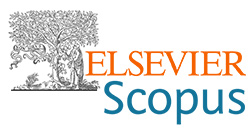Investigating the hydrophobic properties and corrosion resistance of copper surfaces via octadecanoic acid chemical deposition technique
DOI:
https://doi.org/10.62638/ZasMat1390Abstract
This study investigates the enhancement of copper’s hydrophobicity and corrosion resistance through the chemical deposition of octadecanoic acid. Structural and chemical modifications of the treated copper surfaces were analyzed using X-ray Diffraction (XRD), Scanning Electron Microscopy (SEM), and Energy-Dispersive X-ray Spectroscopy (EDS). SEM images revealed significant alterations in surface topography, promoting water repellency, while EDS confirmed the uniform coating of octadecanoic acid. XRD analysis showed that the crystalline structure of copper was preserved. Hydrophobicity was quantitatively assessed through contact angle measurements, which increased from 75° for bare copper to 121.5° for the octadecanoic acid-coated copper, confirming the transition to a hydrophobic surface. Water jetting and water bouncing tests demonstrated superior water repellency and self-cleaning efficiency of the coated surfaces. The contact angle measurement for the coated surface reached approximately 160° during the bouncing tests, indicating highly hydrophobic behaviour. Corrosion resistance was evaluated using dynamic potential polarization and electrochemical impedance spectroscopy (EIS). The dynamic polarization curve indicated a corrosion potential (Ecorr) of -0.0700 V for the coated copper, compared to -0.2036 V for the uncoated copper. The corrosion current density (Icorr) for the coated copper was 3.577 × 10⁻⁶ A/cm², significantly lower than the bare copper's value of 2.214 × 10⁻⁵ A/cm². The corrosion rate of the coated copper was reduced to 1.388 × 10⁻¹ mm/a from 3.226 × 10⁻¹ mm/a for the uncoated copper, resulting in an efficiency of 83.8%. These findings demonstrate that octadecanoic acid is an effective and cost-efficient protective coating for enhancing copper's durability and functionality, especially in moisture-prone environments.
Keywords:
copper, corrosion resistance, hydrophobicity, octadecanoic acid, self-cleaning, surface modificationReferences
Copper drives electric vehicles [Internet]. Copper Alliance: Copper Development Association Inc. 2023. Available form: https://www.copper.org./
Jha, K. K., Armstrong, M., Kumar, S. S., Kumar, M. V., & Charan, G. S. S. (2022). A recent examination on the performance of heat pipes in nanofluids in enhancing the thermodynamic properties. Materials Today: Proceedings, 60(3): 1920-1926. https://doi.org/10.1016/j.matpr.2021.12.587
Copper Market Size, Share, and Trends 2024 to 2034 [Internet]. Semiconductor and Electronic: Copper Market 2024. Available form: https://www.precedenceresearch.com/
Armstrong M, Sivasubramanian M. Experimental examination over heat exchanging capacity on the hollow pipe incorporated with corrugated copper plate dividend and baffles. International Journal of Innovative Technology and Exploring Engineering. 2019; 9(2S2): 411-414. https://doi.org/10.35940/ijitee.B1070.1292S219
Armstrong, M., Mahadevan, S., Selvapalam, N., Santulli, C., Palanisamy, S., & Fragassa, C. (2023). Augmenting the double pipe heat exchanger efficiency using varied molar Ag ornamented graphene oxide (GO) nanoparticles aqueous hybrid nanofluids. Frontiers in Materials, 10, 1240606. https://doi.org/10.3389/fmats.2023.1240606
Lv, Y., & Liu, M. (2019). Corrosion and fouling behaviours of copper-based superhydrophobic coating. Surface Engineering, 35(6), 542–549. https://doi.org/10.1080/02670844.2018.1433774
Tong, Q., Fan, Z., Wang, B., Liu, Q., Bo, Y., & Qian, L. (2021). Preparation and Application of Superhydrophobic Copper Mesh by Chemical Etching and In-situ Growth. Frontiers in Chemistry, 9, 737550. https://doi.org/10.3389/fchem.2021.737550
Baxevani, A., Stergioudi, F., Patsatzis, N., Malletzidou, L., Vourlias, G., & Skolianos, S. (2023). Preparation and Characterization of Stable Superhydrophobic Copper Foams Suitable for Treatment of Oily Wastewater. Coatings, 13(2). 13020355. https://doi.org/10.3390/coatings13020355
Armstrong, M., Sivasubramanian, M., Selvapalam, N., & Jha, K. K. (2024). Exploring the Heat Transfer Performance of Cylindrical Heat Pipes with varied molar Ag-Doped Go Hybrid Nanofluids — An Empirical Study. Heat Transfer Research, 55(2), 55-71.https://doi.org/10.1615/HeatTransRes.2023049011
Li, H., Lu, Y., Zou, X. Y., Wang, C., & Wei, H. (2020). One Step Preparation of Superhydrophobic Surface on Copper Substrate with Anti-Corrosion and Anti-Icing Performance. International Journal of Electrochemical Science, 15(11), 10674-10683. https://doi.org/10.20964/2020.11.16
Armstrong, M., Sivasubramanian, M., Selva Palam, N., Adam Khan, M., & Rajaganapathy, C. (2021). A recent examination on the nano coating techniques in heat transfer applications. In Materials Today: Proceedings, 46, 7942–7947. https://doi.org/10.1016/j.matpr.2021.02.660.
Song, Z., Zhang, S., Ding, L., Wu, X. and Long, N., (2024). The preparation and corrosion resistance of superhydrophobic coating on Cu plate via two-step electrodeposition. Anti-Corrosion Methods and Materials, 71(1), pp.92-102.
Kaseem, M., Safira, A.R. and Fattah-alhosseini, A., (2024). Development of superhydrophobic protective coatings through surface functionalization of porous MgO with transition metal salts of palmitic acid. Journal of Industrial and Engineering Chemistry, 136, pp.440-452
Žerjav, G., Lanzutti, A., Andreatta, F., Fedrizzi, L., & Milošev, I. (2017). Characterization of self-assembled layers made with stearic acid, benzotriazole, or 2-mercaptobenzimidazole on surface of copper for corrosion protection in simulated urban rain. Materials and Corrosion, 68(1), 30–41. https://doi.org/10.1002/maco.201608954
Kim, H., Biswas, J., & Choe, S. (2006). Effects of stearic acid coating on zeolite in LDPE, LLDPE, and HDPE composites. Polymer, 47(11), 3981-3992 . https://doi.org/10.1016/j.polymer.2006.03.068
Jeong, S. B., Yang, Y. C., Chae, Y. B., & Kim, B. G. (2009). Characteristics of the treated ground calcium carbonate powder with stearic acid using the dry process coating system. Materials Transactions, 50(2), 409-414. https://doi.org/10.2320/matertrans.MRP2008351
Ng, W. F., Wong, M. H., & Cheng, F. T. (2010). Stearic acid coating on magnesium for enhancing corrosion resistance in Hanks’ solution. Surface and Coatings Technology, 204(11) 1823-1830, . https://doi.org/10.1016/j.surfcoat.2009.11.024
Gupta, R. K., Mensah-Darkwa, K., Sankar, J., & Kumar, D. (2013). Enhanced corrosion resistance of phytic acid coated magnesium by stearic acid treatment. Transactions of Nonferrous Metals Society of China (English Edition), 23(5), 1237-1244. https://doi.org/10.1016/S1003-6326(13)62588-1
Nguyen, T. T., Nguyen, V. K., Pham, T. T. H., Pham, T. T., & Nguyen, T. D. (2021). Effects of surface modification with stearic acid on the dispersion of some inorganic fillers in pe matrix. Journal of Composites Science, 5(10), 270. https://doi.org/10.3390/jcs5100270
Liu, W., Qiao, X., Liu, S., Shi, S., & Li, J. (2019). Study of hydrophobic modification of copper-coated mica and its spectrum, molecular structure and properties. Journal of Molecular Structure, 1186, 440–447. https://doi.org/10.1016/j.molstruc.2019.03.043
Hu, C., Xie, X., & Ren, K. (2021). A facile method to prepare stearic acid-TiO2/zinc composite coating with multipronged robustness, self-cleaning property, and corrosion resistance. Journal of Alloys and Compounds, 882. https://doi.org/10.1016/j.jallcom.2021.160636
Ma, R., Li, R., Niu, Q., Zeng, Y., Li, J., Bai, S., & Cheng, Y. (2023). Preparation of Superhydrophobic Surfaces Based on Copper Mesh Substrates and Its Application Performance. ACS Omega, 8(48), 45616–45625. https://doi.org/10.1021/acsomega.3c05834
Armstrong, M., Sivasubramanian, M., Selvapalam, N., Pavitra, R., Rajesh Kanna, P., & Lenin, H. (2023). Synthesis and Empirical Analysis of the Thermophysical Characteristics of GO-Ag Aqueous Hybrid Nanofluid Using Environmentally Friendly Reducing and Stabilizing Agents. Advances in Materials Science and Engineering, 2023. https://doi.org/10.1155/2023/5585132
Chen, Y., Zhang, X., Wang, B., Lv, M., Zhu, Y., & Gao, J. (2017). Fabrication and characterization of novel shape-stabilized stearic acid composite phase change materials with tannic-acid-templated mesoporous silica nanoparticles for thermal energy storage. RSC Advances, 7(26), 20935–20944. https://doi.org/10.1039/c7ra00964j
Hou, W., Shen, Y., Tao, J., Xu, Y., Jiang, J., Chen, H., & Jia, Z. (2020). Anti-icing performance of the superhydrophobic surface with micro-cubic array structures fabricated by plasma etching. Colloids and Surfaces A: Physicochemical and Engineering Aspects, 586. https://doi.org/10.1016/j.colsurfa.2019.124180
Armstrong, M., Sivasubramanian, M., Selvapalam, N., & Pavitra, R. (2024). Green synthesis, characterization and thermophysical properties of diverse molar Ag decorated GO hybrid nanofluids. Chemical Engineering Communications, 211(10), 1610–1629. https://doi.org/10.1080/00986445.2024.2365766
Mohamed, M. E., & Abd-El-Nabey, B. A. (2020). Facile and Eco-Friendly Method for Fabrication of Superhydrophobic Surface on Copper Metal. ECS Journal of Solid State Science and Technology, 9(6), 061006. https://doi.org/10.1149/2162-8777/ab9dc7
Jain, R., & Pitchumani, R. (2018). Facile Fabrication of Durable Copper-Based Superhydrophobic Surfaces via Electrodeposition. Langmuir, 34(10), 3159–3169. https://doi.org/10.1021/acs.langmuir.7b02227
Jia, C., Zhu, J., & Zhang, L. (2022). An Anti‐Corrosion Superhydrophobic Copper Surface Fabricated by Milling and Chemical Deposition. Coatings, 12(4), 442. https://doi.org/10.3390/coatings12040442
Trisnanto, S. R., Setiawan, I., Sunnardianto, G. K., & Triawan, F. (2019). Stearic acid-modified CuO coating metal surface with superhydrophobicity and anti-corrosion properties. Journal of Engineering Research (Kuwait), 2019.







